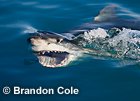|
Selects
marine photos for the month
We've
created this new feature to highlight some of our favorite photographs
from over the years, and to give you a quick, easy look into the subject
diversity of our photo library. We will update this page monthly, so check
back regularly.
 |
km2184.
Photo of Humpback Whales (Megaptera novaeangliae) bubble-net
feeding in Alaska. Certainly one of the top marine life spectacles
on the planet, this all-they-can-eat herring buffet behavior sees
up to twenty of these baleen leviathans working together to feast
on baitfish during summer months. Whales dive below the school of
herring or capelin, and then while circling release bubble streams
which rise and trap the prey within a circular curtain of bubbles.
The whales, growing up to 50' long and weighing up to 40 tons,
then ascend with mouths open into the fish and gulp sea water and
bait. This picture captures nearly twenty whales just as they
erupt from the sea's surface with mouths agape. We have one of the
strongest collections of photographs illustrating this exciting
predatory behavior. Of course this coverage complements our
class-leading library of dramatic breaching images, tail flukes at
sunset, and underwater perspectives of this charismatic megafauna,
still an endangered species. |
|

|
qm40210-D.
Our photographs of Great White Sharks (Carcharodon carcharias)
have been published on dozens of magazine covers, as billboards,
in advertisements for multinational companies, and in editorial
and educational products globally. This evocative new picture of
an adult male "white pointer" swimming just under the
surface was made recently on an expedition to South Africa's Dyer
Island, one of the best places on Earth to view this apex
predator. A shark cage diving industry is booming in South Africa,
as well as South Australia and Mexico's Guadalupe Island. We have
photos from all three locations. Though undoubtedly dangerous and
responsible for dozens of human deaths, the white shark's
nightmarish killer reputation is not statistically warranted. More
people die each year from dog bites and bee stings than in attacks
by all species of sharks worldwide. Currently some 50 to 100
million sharks are killed by man annually. The most feared
"monster" on our planet has more to fear from us that we
do from it. |
|

|
qe0097-D. Coral reefs
are the rainforests of the sea. The Fiji Islands, in the tropical
South Pacific Ocean northeast of Australia, have some of the
healthiest, most colorful coral kingdoms we've ever photographed.
Hundreds of species of fish and invertebrates thrive in this
ecosystem. This digital photograph from the Bligh Waters area in
central Fiji shows soft corals (Dendronephthya sp. and
Chironephthya sp.), branching cup corals (Tubastraea micrantha)
and Scalefin anthias (Pseudanthias squammipinnis) schooling fish
along a wall at a dive site called GoMo, at 80 feet deep. In 2008
we scuba dived the Lomaiviti Group's most famous sites for ten
days onboard the live-aboard boat Nai'a, a pioneer of diving in
Fiji. We have shot in this island nation many times before and it
remains one of our favorite tropical destinations for underwater
photography. Browse through hundreds of Fijian marine life photos
on our web site using our keyword search engine, or give us a call
and we'll prepare a custom submission for you. We can also deliver
complete articles (photos and text packages). |
|

|
pp0067-D.
A Giant Pacific Octopus (Enteroctopus dofleini) interacting with
Melissa Cole (model released) in British Columbia, Canada. The
world's largest species of octopus, it's an intelligent and often
curious invertebrate which can grow to over 15' wide tentacle tip
to tentacle tip. An encounter with this cephalopod is widely
considered one of the most exciting sitings cold water divers can
experience in the Pacific Northwest. They range from Alaska south
to California. This high resolution digital image was captured
with a Canon 1Dsmark II camera while diving off Vancouver Island.
Giant Octopus feed primarily on clams and crabs and are masters of
camouflage. Amazingly enough they live only four or five years on
average. Females guard and care for thousands of rice grain-sized
eggs they deposit under rocks. |
 |
mb149. This underwater
picture from our Sockeye Salmon collection depicts the endangered
Pacific Salmonid species in spawning coloration and was taken in
freshwater in the Adams River in the interior of British Columbia
during October. After three to four years living in the Pacific
Ocean, sockeye salmon (Oncorhynchus nerka), sometimes called
"red salmon", swim back up the river in which they were
born. They are on a mission to spawn and die. Their bodies change
color from silver to red, and a male's snout transforms into a
hooked beak. After a grueling trek upriver hundreds of miles,
their energy spent and bodies wasting away (they do not feed once
they enter freshwater), they summon the strength for one final
act. Males and females pair up in shallow stream beds with just
the right size gravel free of sediment. The smaller female
excavates a nest or "redd" in which she deposits small
pink eggs, which the male then fertilizes. Shortly after the
parents will die, and their decomposing carcasses will enrich the
river system for the next generation. The saga of the saga is an
amazing, inspirational story. We also have photo coverage of the
other four Pacific salmon species- chinooks (kings), pinks
(humpbacked), coho (silver), and chum (dog). |
| previous Selects
pages: 1 |
|